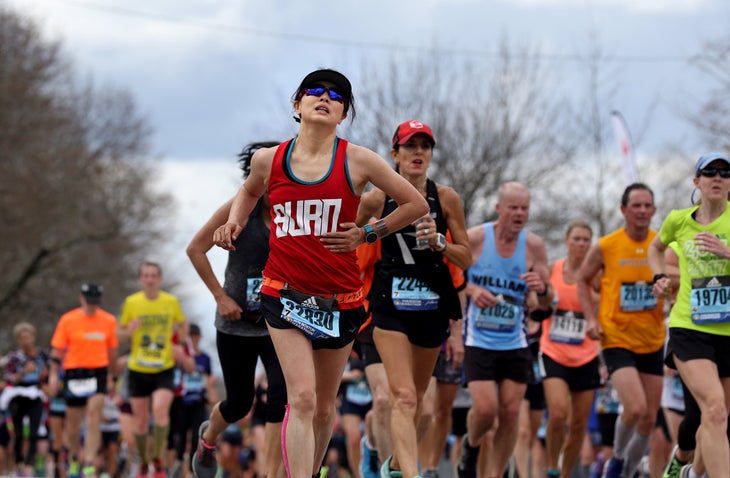One of my pet peeves as a coach is the oft-heard advice: “Attack the hill, don’t be weak, don’t let up.” It’s one of those things runners get taught when they are young that are just plain wrong. The idea, it seems, is to show your strength and grit, to prove to yourself and your competitors that you are, literally, king of the hill. Or it is an attempt to keep the pace consistent, to not let the hill rob any seconds through sheer willpower. I can’t count the number of runners I’ve known who’ve been taught just that.
The only problem is that it doesn’t work that way.
When I was first starting to race, on rolling courses in Michigan, I quickly realized that most of the runners around me struggled up the hills, then were forced to recover on the downgrades. Then some older, wise soul in my running club told me that the best way to run hills effectively begins by learning how to run fast on the downgrades.
“Lean forward,” he said, “and let your torso fall down the hill. Then move your legs fast enough to keep up.” Run downhill effectively and you don’t need to kill yourself going up.
Disproportionate Effort
Years later, I came under the tutelage of Alberto Salazar, long before his fall from grace. And whatever you may think of him today, he was an extremely good tactician, with a scientist’s bent toward figuring out the best way to do everything as perfectly as possible.
One of the things he told me was that, curious about the best way to run hills, he’d once gone out and run a 400m hill at “hard,” “medium,” and “easy” efforts — as determined by a heart rate monitor. Then, he went to a nearby track and replicated those efforts on the flat, comparing his times.
What he found validated the wisdom of my long-ago teammate. Uphill, the time difference in running hard, medium, or easy, was vastly less than it is on the flat. He compared running hard uphill to trying to run fast in sand. You can blow an enormous amount of energy and accomplish very little.
Flash forward more years, and I found myself coaching marathoners for the Portland Marathon, which at the time included a notorious 175-foot climb to the top of Portland’s highest bridge over the Willamette River. The climb came at about mile 17, and pretty much everyone was terrified of it.
My answer: run the same effort you would on the flat (not pace). The bridge will suck about a minute of time out of your life, but there’s nothing you can do about that, and if you try to get up it faster, you will pay for it, later.
Calculating Heartbreak
Support for this comes not just from Salazar, but exercise physiologist and coach Jack Daniels, who once estimated the effect of hills on runners doing the Boston marathon. His conclusion, which I use with my runners, was that each 50 feet of climbing slows you down by about 15 seconds. I.e., that 175-foot bridge means about 52 seconds…close enough to “a minute” to justify what I was saying.

Yes, you can run up a hill like that faster. But if you do, you need to view it as the equivalent of a hard surge. Can you sustain it? And if you can’t, how much more will you give back on the recovery? Better is to run the upgrade at about the same energy level you’ve been running on the flats and let the time be what it is. When you reach the top, you want to feel “released” and eager to go fast, rather than spaghetti-legged, gasping for breath, and desperate for a chance to recover.
Discipline and Practice
Finding the discipline to approach hills this way takes deliberate effort. “If I don’t think about it, I’ll just push,” says Janne Heinonen, one of Portland, Oregon’s best masters runners. “I have to make a conscious effort to hold back. It’s hard, because the steeper it is, the more my instinct is to surge up it.”
Luckily, there are ways to practice this. One of my favorites is what I call “dip-bounces.” Find a route with a small dip leading to an equally small hill. On the descent, lean forward and practice the sense of “falling” down the hill, being careful not to overstride. Then practice carrying your momentum up the other side using the same effort. By reversing the order of down and up, you practice the faster descent fresh and have already reaped the benefits so you can relax and float up.
When I did these with training partners, I’d always find myself two to three strides ahead of them, even with a dip of only 5-6 feet, waiting for them to catch up. Do these whenever you can, making them so habitual that you can’t imagine running such terrain any other way, regardless of the order of ups and downs.
Another, more advanced, is hill up-and-overs. For these, find a longish paved hill that climbs to a smooth crest then drops down the backside (if the climbs are asymmetrical in grade and/or length, you can alternate the “fast” and “slow” directions. Start 400m before the top and run up, over the top and down the backside.
The target is to hit the top feeling not like you need to back off and recover, but instead, feeling released. This objective is twofold: (a) to practice fast, controlled running on the descent, and (b) to figure out your own most efficient way to cover the entire distance, up and over the hill. After all, the ultimate goal isn’t to be as fast as possible to the top of the hill; it’s to be as fast as you can be to the finish line for the overall race.
There are, of course, races in which you need a different approach. If the descent is too steep, you may need to adjust. If the descent is both excessively steep and technical (as can sometimes occur in trail races or cross-country events) there may be situations in which the primary goal is to remain upright. For these, the strategy is to attack when the footing is good, and recover when it isn’t.
Another exception could be when a hill falls close to the finish and you don’t have distance or terrain to make up for falling behind. Even in this situation, however, you won’t benefit by pushing so hard you have to back off at the top — the uphill push should be proportional to your overall increase in effort and pace.
In general, the best results come not from attacking hills as hard as you can but from learning how to match your energy expenditure to the course — so you don’t just “beat” the hills but run your best race.


